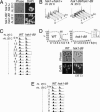Hsk1 kinase is required for induction of meiotic dsDNA breaks without involving checkpoint kinases in fission yeast
- PMID: 16698922
- PMCID: PMC1472441
- DOI: 10.1073/pnas.0602498103
Hsk1 kinase is required for induction of meiotic dsDNA breaks without involving checkpoint kinases in fission yeast
Abstract
Cdc7 kinase, conserved through evolution, is known to be essential for mitotic DNA replication. The role of Cdc7 in meiotic recombination was suggested in Saccharomyces cerevisiae, but its precise role has not been addressed. Here, we report that Hsk1, the Cdc7-related kinase in Schizosaccharomyces pombe, plays a crucial role during meiosis. In a hsk1 temperature-sensitive strain (hsk1-89), meiosis is arrested with one nucleus state before meiosis I in most of the cells and meiotic recombination frequency is reduced by one order of magnitude, whereas premeiotic DNA replication is delayed but is apparently completed. Strikingly, formation of meiotic dsDNA breaks (DSBs) are largely impaired in the mutant, and Hsk1 kinase activity is essential for these processes. Deletion of all three checkpoint kinases, namely Cds1, Chk1, and Mek1, does not restore DSB formation, meiosis, or Cdc2 activation, which is suppressed in hsk1-89, suggesting that these aberrations are not caused by known checkpoint pathways but that Hsk1 may regulate DSB formation and meiosis. Whereas transcriptional induction of some rec genes and horsetail movement are normal, chromatin remodeling at ade6-M26, a recombination hotspot, which is prerequisite for subsequent DSB formation at this locus, is not observed in hsk1-89. These results indicate unique and essential roles of Hsk1 kinase in the initiation of meiotic recombination and meiosis.
Conflict of interest statement
Conflict of interest statement: No conflicts declared.
Figures






Similar articles
-
Rad3-Cds1 mediates coupling of initiation of meiotic recombination with DNA replication. Mei4-dependent transcription as a potential target of meiotic checkpoint.J Biol Chem. 2006 Jan 20;281(3):1338-44. doi: 10.1074/jbc.M505767200. Epub 2005 Nov 14. J Biol Chem. 2006. PMID: 16286472
-
Hsk1-Dfp1/Him1, the Cdc7-Dbf4 kinase in Schizosaccharomyces pombe, associates with Swi1, a component of the replication fork protection complex.J Biol Chem. 2005 Dec 30;280(52):42536-42. doi: 10.1074/jbc.M510575200. Epub 2005 Oct 31. J Biol Chem. 2005. PMID: 16263721
-
Regulation of initiation of S phase, replication checkpoint signaling, and maintenance of mitotic chromosome structures during S phase by Hsk1 kinase in the fission yeast.Mol Biol Cell. 2001 May;12(5):1257-74. doi: 10.1091/mbc.12.5.1257. Mol Biol Cell. 2001. PMID: 11359920 Free PMC article.
-
Regulation of chromosome dynamics by Hsk1/Cdc7 kinase.Biochem Soc Trans. 2013 Dec;41(6):1712-9. doi: 10.1042/BST20130217. Biochem Soc Trans. 2013. PMID: 24256280 Review.
-
Regulation Mechanisms of Meiotic Recombination Revealed from the Analysis of a Fission Yeast Recombination Hotspot ade6-M26.Biomolecules. 2022 Nov 26;12(12):1761. doi: 10.3390/biom12121761. Biomolecules. 2022. PMID: 36551189 Free PMC article. Review.
Cited by
-
AtPRD1 is required for meiotic double strand break formation in Arabidopsis thaliana.EMBO J. 2007 Sep 19;26(18):4126-37. doi: 10.1038/sj.emboj.7601815. Epub 2007 Aug 30. EMBO J. 2007. PMID: 17762870 Free PMC article.
-
Structural Basis for the Activation and Target Site Specificity of CDC7 Kinase.Structure. 2020 Aug 4;28(8):954-962.e4. doi: 10.1016/j.str.2020.05.010. Epub 2020 Jun 9. Structure. 2020. PMID: 32521228 Free PMC article.
-
CDC28 phosphorylates Cac1p and regulates the association of chromatin assembly factor I with chromatin.Cell Cycle. 2015;14(1):74-85. doi: 10.4161/15384101.2014.973745. Cell Cycle. 2015. PMID: 25602519 Free PMC article.
-
Metabolic stress-induced long ncRNA transcription governs the formation of meiotic DNA breaks in the fission yeast fbp1 gene.PLoS One. 2024 Jan 22;19(1):e0294191. doi: 10.1371/journal.pone.0294191. eCollection 2024. PLoS One. 2024. PMID: 38252660 Free PMC article.
-
Multiple pathways can bypass the essential role of fission yeast Hsk1 kinase in DNA replication initiation.J Cell Biol. 2011 Oct 31;195(3):387-401. doi: 10.1083/jcb.201107025. Epub 2011 Oct 24. J Cell Biol. 2011. PMID: 22024164 Free PMC article.
References
Publication types
MeSH terms
Substances
LinkOut - more resources
Full Text Sources
Molecular Biology Databases
Miscellaneous

